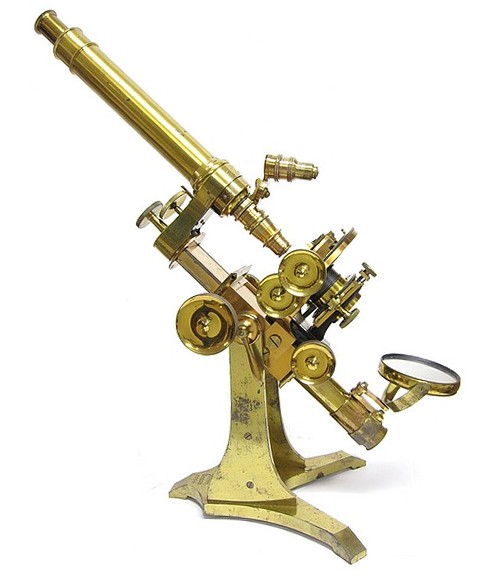
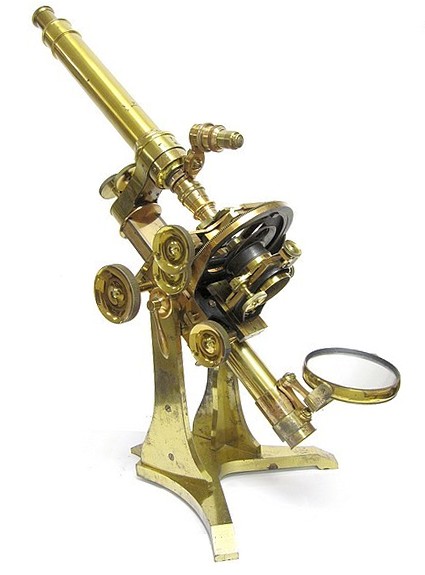
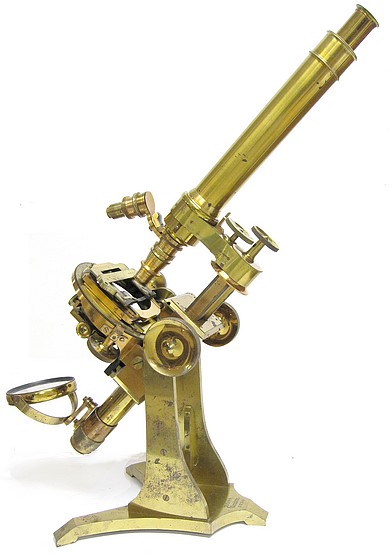
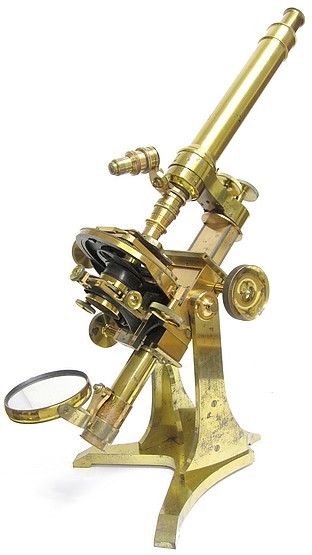
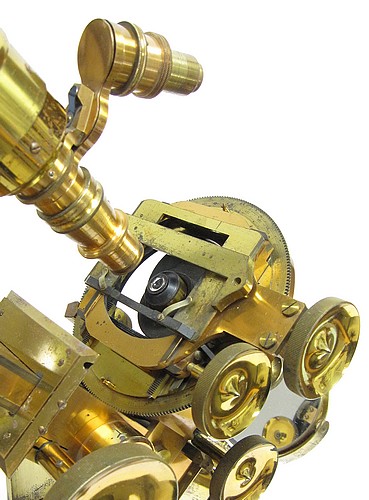
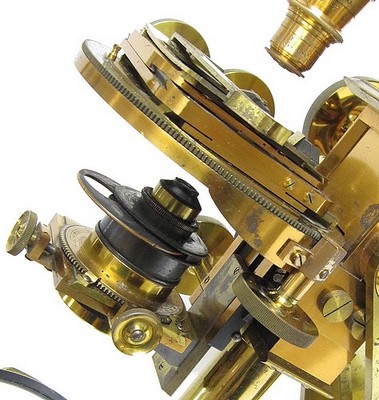
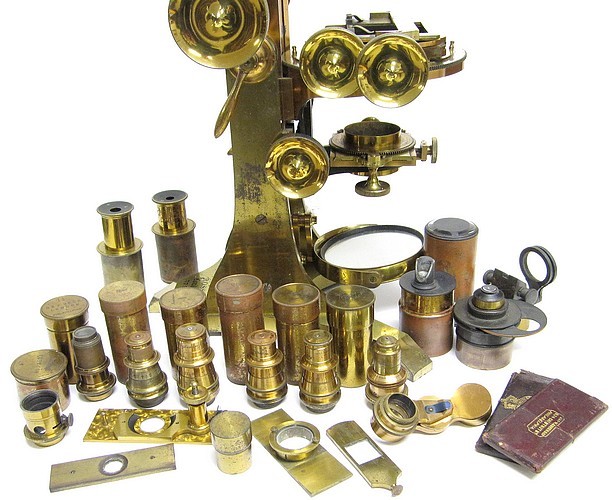
The storage case has double doors thus allowing the accessories to be stored on each door as well as within the case. Among the surviving accessories are two oculars marked A and B, a substage condenser with diaphragm wheel, a substage Nachet's prism for oblique illumination, a darkfield condenser, brass bound eyepiece and stage micrometers, a glass micrometer in a leather case, a Maltwood's finder in a leather case, a vertical illuminator stored in a brass canister marked R&J Beck, a double objective changer, a Wollaston's camera lucida, a Rousselet's compressorium, and a live box. There are six objectives each with a brass storage canister among which are a Beck 1 1/2, a Ross 1/10, and four Tolles immersion objectives marked 1/5, 1/10, 1/12, and 1/25-inch. A small brass canister contains an extra front lens for a Tolles objective.
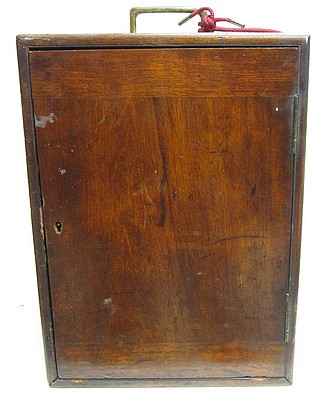
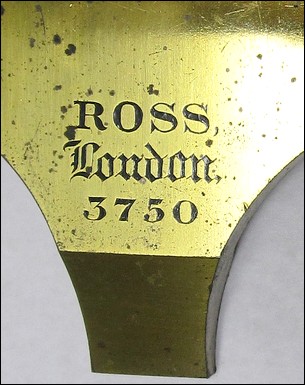
The following was extracted from the 6th Edition of Catpenter's The Microscope and its Revelations, 1868.
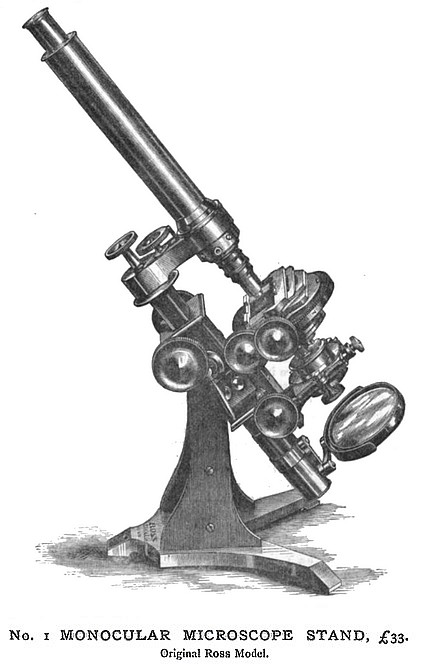
(illustration from the 1875 catalog)
Ross's First-class Microscope.* To this instrument the first place may fairly be assigned without any invidious preference; since it is the one which was earliest brought (in all essential features at least) to its present form. The general plan of Mr. Ross's Microscope is essentially the same as that which we have already seen to be adopted in a simpler form by many other makers; but it is carried out with the greatest attention to solidity of construction, in those parts especially which are most liable to tremor, and to the due balancing of the weight of the different parts upon the horizontal axis. The 'coarse' adjustment is made by the large milled-head situated just behind the summit of the uprights, which turns a pinion working into a rack cut on the back of a very strong flattened Stem that carries the transverse arm at its summit; a second milled-head (which is here concealed by the stage-fittings) is attached to the other end of the axis of the pinion, so as to be worked with the left hand. The 'fine' adjustment is effected by the milled-head on the transverse Arm just behind the base of the body'; this acts upon the 'nose' or tube projecting below the arm, wherein the objectives are screwed. The other milled-head, seen at the summit of the stem, serves to secure the transverse arm to this, and may be tightened or slackened at pleasure, so as to regulate the traversing movement of the arm; this movement is only allowed to take place in one direction, namely, towards the right side, being checked in the opposite by a 'stop,' which secures the coincidence of the axis of the Body with the centre of the Stage, and with the axis of the Illuminating apparatus beneath it. It is in the movements of the Stage that the greatest contrivance is shown: these are three, namely, a traversing movement from side to side, a traversing movement from before backwards, and a rotatory movement.
The traversing movements, which allow the platform carrying the object to be shifted about an inch in each direction, are effected by the two milled heads situated at the right of the stage, and these are placed side by side, in such a position that one may be conveniently acted-on by the fore-finger, and the other by the middle-finger, the thumb being readily passed from one to the other. The traversing portion of the stage carries the Platform whereon the object is laid, which has a ledge at the back for it to rest against; and this platform has a sliding movement of its own, from before backwards, by which the object is first brought near to the axis of the Microscope, its perfect adjustment being then obtained by the traversing movement. To this platform, and to the traversing slides which carry it, a rotatory movement is imparted by a milled-head placed underneath the stage on the left-hand side; for this milled-head turns a pinion which works against the circular rack, whereby the whole apparatus above is carried round about two-thirds of a revolution, without in the least disturbing the place of the object, or removing it from the field of the Microscope. The graduation of the circular rack, moreover, enables it to be used as a Goniometer. In the improved form of this instrument here represented, the whole Stage-apparatus is made so thin, and the opening beneath so large, as to permit the employment of light of extreme obliquity; and to enable the Mirror to afford this, it is mounted upon an extending arm, the socket of which slides upon a cylindrical stem. Below the stage, and in front of the stem that carries the mirror, is a dovetail sliding bar, which is moved up and down by the milled head shown at its side; this sliding-bar carries what is termed by Mr. Ross the 'Secondary Stage, which consists of a cylindrical tube for the reception of the Achromatic Condenser, Polarizing prism, and other fittings; it is here shown as fitted with a Condenser specially devised by Mr. T. Ross for the illumination of a large field under low magnifying powers. To this Secondary Stage, also, a rotatory motion is communicated by the turning of a milled-head; and a traversing movement of limited extent is likewise given to it by means of two screws, one on the front and the other on the left-hand side of the frame which carries it in order that its axis may be brought into perfect coincidence with the axis of the body. The special advantages of this instrument consist in its perfect steadiness, in the admirable finish of its workmanship, and in the variety of movements which may be given both to the Object and to the fittings of the Secondary Stage. Its disadvantages consist in the want of portability that necessarily arises from the substantial mode of its construction; and in the multiplicity of its movable parts, which presents to the beginner an aspect of great complexity. This complexity, however, is much more apparent than real; for each of these parts has an independent action of its own, the nature of which is very soon learned; and the various milled-heads are so disposed that the hand readily (and at last almost instinctively) finds its way from one to the other, so as to make any required adjustment whilst the eye is steadily directed to the object. To the practiced observer, therefore, this multiplication of adjustments is a real saving of time and labour, enabling him to do perfectly and readily what might otherwise require much trouble, besides affording him certain capabilities which he would not otherwise possess at all.
*This instrument, devised by the late Mr. Andrew Ross, has undergone very important modifications at the hands of his son, Mr. Thomas Ross; having been altogether considerably lightened, and the construction of the Stage having been greatly improved.
At the time this microscope was manufactured, it was considered to be the standard top-of-the-line model offered by the Ross firm. It was sold with either monocular or Wenham binocular tubes. An earlier version of this microscope from about 1855 made by Andrew Ross is also represented in this collection; in most respects this early version is quite similar to the microscope shown here except for the improvements introduced by Thomas Ross. For a history of the Ross firm see The Ross of London chronology by T. Wayland.
This instrument was purchased from a descendant of a previous owner. In the early 1980's, his uncle, who was employed by the Rose-Hulman Institute of Technology, rescued the microscope when the college was disposing of some old equipment. The Rose-Hulman Institute of Technology was founded by the industrialist Chauncey Rose as the Terre Haute School of Industrial Science in 1874, located at in Terre Haute, Indiana.
A year later, the institution was renamed the Rose Polytechnic Institute In later years, it was once again renamed as it is today. From the beginning, the school was dedicated to teaching science and engineering. While this Ross microscope dates close to the year of the college's founding, student enrollment did not begin until 1883 up to which time the facility was being prepared and books and equipment were being accumulated. In the 1909 publication of the Rose Polytechnic Institute: Memorial Volume, it is stated that in 1882 "An opportunity for the purchase of the apparatus and library of the late Dr. John Bacon, of Harvard College, was seized by the Board, and an admirable collection of instruments and scientific books was added to the resources of the school. "
In an 1882 issue of the American Monthly Microscopical Journal, the advertisement shown at the right appeared describing some of the instruments belonging to Prof. Bacon that were sold. Since a Ross microscope is not specifically mentioned, one cannot be certain if this Ross microscope acquired by the college was among those instruments belonging to Dr. Bacon. However, it is quite likely that the Tolles objectives that accompany this Ross microscope are those that were among the 18 that were in the Bacon collection since found attached to the inside of the cap of the 1/10th Tolles objective canister was a paper with "x Bacon" written upon it. Tolles sometimes marked the top of the inside of his objectives with the dates they were completed. Accordingly on this basis, it can be determined that the four objectives were made either in 1873 or 1874.
In an 1881 issue of the same journal, there appeared the following short obituary for Dr. John Bacon Jr.:
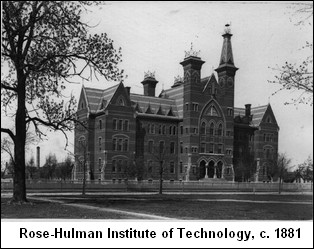
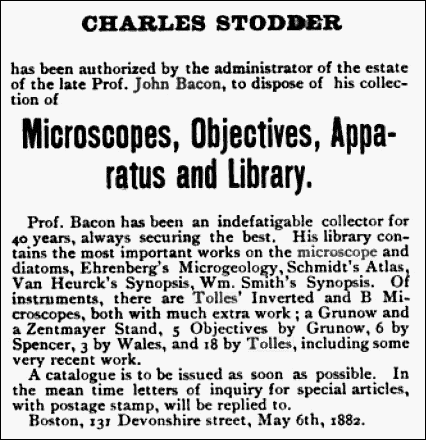
Prof. John Bacon. We have also to record the death of Prof. John Bacon, at his home, in Boston, on Monday, Nov. 28th. Prof. Bacon was one of the earliest American microscopists. For nearly forty years he has seen the progress of Microscopical study and the improvements in the instrument, securing for himself whatever seemed to be of value among the latter.
About the year 1847 he visited Andrew Ross, in London, who then informed him that 147 degrees was the utmost limit of angular aperture that could be given to an objective. For fourteen years he was Professor of chemistry in Harvard College, but in 1871 he resigned on account of ill health; since then he has given special attention to the study of diatoms. His cabinet of diatom-preparations is very valuable, and his library contains perhaps the most complete collection of works on the diatoms in the country. He was a man of ability and an excellent chemist, but of a retiring disposition, and therefore almost unknown to the general public.
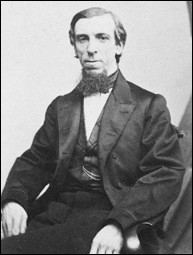
Dr. John Bacon Jr. 1817-1881
Also, see this article which describes his role as the first chemist and microscopist appointed in the early years of the Massachusetts General Hospital. A more complete biography of John Bacon was published in the Proceedings of the American Academy of Art and Sciences, 1883.
The four Tolles objectives (1/5, 1/10, 1/12, and 1/25-inch) associated with this microscope are important. They were made at the time when there was an ongoing controversy concerning the angle of aperture that could be achieved with such Tolles homogeneous immersion objectives. For a discussion of the importance of the objectives made by Robert B. Tolles in advancing 19th century microscopy, see the article entitled "The Aperture Wars". Also, see the article "Robert B. Tolles and the Angular Aperture Question" (Proceedings of the American Society of Microscopists, Vol. 6, (1884), pp. 5-39) and The American Monthly Microscopical Journal, (1884), pg. 167